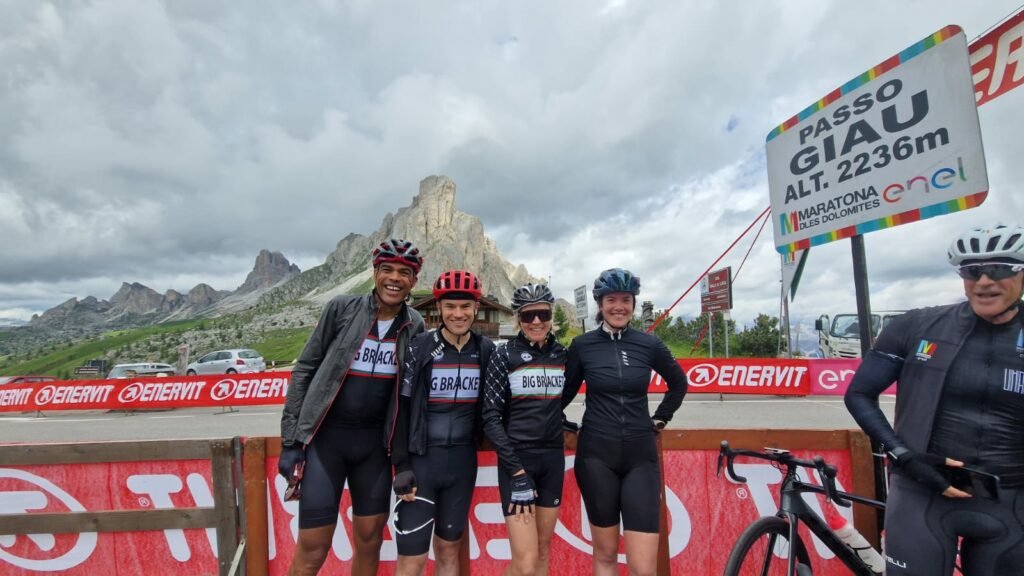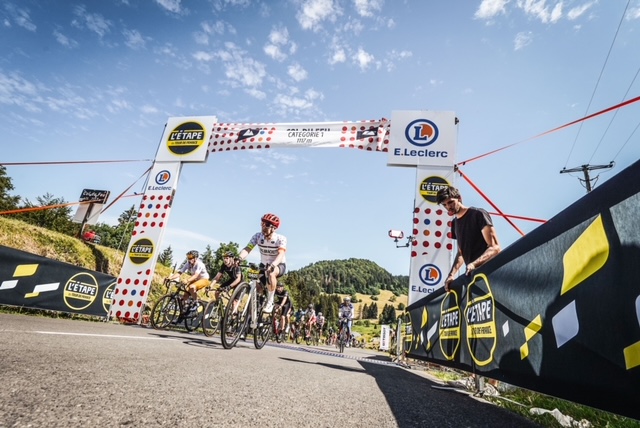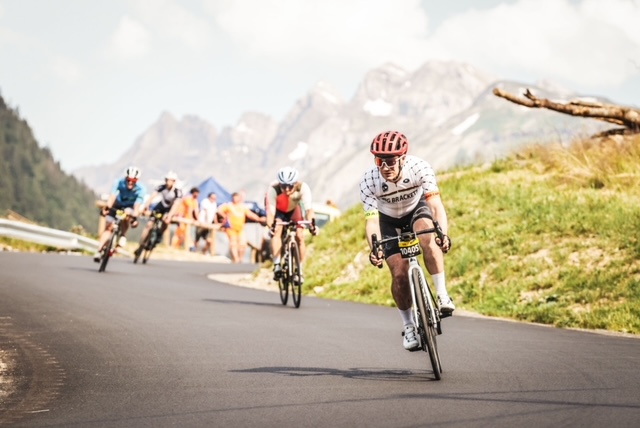One, but if one, why not two, and then why not three ? Summer 2023 was the moment planned for revenge. Revenge on my bike, which had cruelly failed me, after months of training, on le Col du Croix du Fer, in scorching heat, before I even got close to Alpe d’Huez during the 2022 Etape du Tour.
Report by Colin Brown (En).
“So it was that I signed up for the 2023 Etape du Tour. Exacting revenge. Stage 14 of the Tour de France, from Annemasse, on Lake Geneva, to Morzine, high in the French Alps, over the fearsome Col de Joux Plane and Col de la Ramaz. 4000 metres of climbing, over 157 kms, again in the scorching heat of the French summer. A day on closed roads, a few days before the real peloton took on these climbs, when Pogacar could not shake Vingegaard. 12000 amateur cyclists, of all shapes and abilities, got to imagine themselves riding with the superstars of our sport.
And as the determination for revenge hatched in my mind, the idea came up of playing the lottery. And for once I won. This was not the normal lottery, but the lottery for la Maratona dles Dolomiti. The Maratona organisers intelligently eschew the Taylor Swift concert like approach of L’Etape (where you better buy your place immediately on release of the tickets, constantly refreshing your browser, hoping the site doesn’t crash) but rather organised a lottery where 30000 applications are winnowed down to 9000.
Then I started to realise what I had got myself into. The Maratona (4230 metres of climbing over 138kms) was on 2nd July. L’Etape (4000 metres of climbing over 157kms) was on 9 July. One week apart. There was only one thing to do. Find another Gran Fondo to prepare….
[A Gran Fondo, for the readers discovering the term, is an Italian invention. Translating it as “big ride” oversimplifies what it is, but also captures the essence of it. It is generally understood as referring to a timed cycling event (with chip timing), usually on closed roads, usually between 120kms and 200kms and usually with between 2000 and 4000 metres of climbing. It’s competitive, both as to who can win (Victor Lafay this year became the first winner of L’Etape and a stage in the Tour de France) and against oneself (finishing is an achievement, a good time even more so). Many gran fondos now offer shorter routes, for those less ready to go these extremes.]

And as the determination for revenge hatched in my mind, the idea came up of playing the lottery. And for once I won.
So it was that I lined up on 3rd June in Mondorf-les-Bains for the Schleck Gran Fondo. 156kms with 2000 metres of climbing. This was no ordinary Gran Fondo. It was a qualifier for the UCI World Championship Grand Fondo, being held, with the rest of the World Championships, in my home country of Scotland. Perhaps, just perhaps, I could qualify. Imagine competing for the Rainbow Jersey, and in your own country ? I only had to be in the top 25% of my age-group. I had the disadvantage of being elderly, at the top end of the 45-49 age-group. One look at my fellow age-group participants, and one neutralised kilometre later, confirmed, however, what I had suspected all along: that another disadvantage would prevent me from qualifying: not being anywhere near quick enough….
Quite quickly though that didn’t matter at all. How beautiful Luxembourg is (and how good are the roads) ? Until then my knowledge of Luxembourg was the station, bland business hotels and big buildings housing one or other EU institution. In a small peloton, we trammelled along the side of the Moselle, flanked by vineyards, taking turns on the front, the road blocked by police escorts to ensure that we could whizz through the junctions. Then we hit the hills, and the groups dispersed as the route took us through the Mullerthal (Little Switzerland) beautifully formed red sandstone cliffs in the Luxembourgish forest. All still on those perfect roads. I started to cramp a bit as we approached the end. Was it the bout of sickness of the last few days that had caught up with me ? Had I pushed it too hard, in the forlorn hope of qualifying? Unclear. The exhilaration of finishing, coming through the finish line with my last remaining bits of energy, at what for me was a very high average speed, was dampened upon discovering that someone, tragically, had had a fatal accident. That felt surprising. The organisation was amazing, from start to finish, and we’d been carefully marshalled, signalled when to slow down, warned when a tight corner was coming. I couldn’t identify anything to fault the organisers. But it served to remind of the risks of our sport, and of our fragility. But whilst driving back to Brussels, as the BBB team that we’d entered dissected what had happened, I knew I wanted to go back in 2024. Because qualifying didn’t matter. The thrill of the road, the perfect tarmac, the beautiful unimagined forests, the surprisingly tough hills and the excellent organisation was what mattered.
And so, about a month later, I cashed in the winning lottery ticket at the Maratona dles Dolomiti. Arriving in the Dolomites to torrential rain, we wondered what awaited us. A quick tour of the exhibitors area ensued where it was necessary to take shelter next to Top Ganna’s hour-record-beating beautiful Pinarello Bolide rather than gawk in wonder at it. Then after a short warm-up ride on the Saturday (nothing is flat, so no easy warm-up) to the start early in the morning on Sunday. Freezing cold. We’re high in the mountains, and even in the height of summer it’s not necessarily warm (Strava says an average temperature of 9°C for the whole ride). Newcomers (men) start at the back, in the final wave with 8.500 or more riders in front of them (women newcomers start in the second wave).

There, at the top, we had an impromptu BBB reunion, with Tjaša, Antje and Pierre...
With 8.500 or so in front of me I get to practice my rudimentary Italian as we climb around the Sella Ronda “a sinistra”, “a sinistra” (and some Scottish mumbling/cursing)(“move to the left” – subtext, I was climbing quicker than most, but they were not staying on the right hand side of the road). Passo Campolongo, Passo Pordoi, Passo Sella (where I met Antje !), Passo Gardena, came in (relatively) quick succession as the race took the Sella Ronda, round the magnificent Sella plateau as the first shorter loop (with an option to stop there). The longer route then climbed Passo Campolongo (again ! but less “a sinistra” this time, and less mumbling/cursing) (here I caught up with Tjaša) then descending and rolling mostly downhill, except the gorgeous Colle Santa Lucia, before arriving at the fearsome (9.5kms at 9.3% average) and stunningly beautiful Passo Giau, well known from the Giro. There, at the top, we had an impromptu BBB reunion, with Tjaša, Antje and Pierre (Sabri was already way in front of us) where we took a moment to enjoy having managed to make it that far. Then perhaps the world’s most beautiful descent down from Passo Giau took us to the bottom of Passo Falzarego before heading back to Corvara, where the race had started, with the Mur dl Giat (the Smeysberg of the Dolomites – maxxing at 19%), through the supporters zone, as the last obstacle. At the end we received our finisher’s medals and wolfed down some pasta at the extremely well organised finishing camp.

Next was L’Etape. One week later, on the other side of the Alps. Rather than return to Brussels I had to go to Vienna for work. This entailed a complicated exercise of leaving my car at Innsbruck, taking the train back and forth to Vienna, meeting my son – come to explore Vienna after his exams – and then drive late through the night of Friday from Innsbruck to Zurich to make it first to Annemasse and then Morzine on the Saturday. Registration done, the challenge was getting the bus early from Morzine back down to Annemasse for the start (time of the bus not mentioned so as not to scare anyone).

we headed up Joux Plane, where Pogacar and Vingegaard would fight it out a few days later.
12.000 riders massed on the start (thankfully, at least at that moment, significantly warmer than the Maratona) and we rolled over the line in groups of a thousand. But the heat was to catch up with us, as the temperature rose inexorably during the day. The route took us up col de Cou (7 km at 7.7 %), col de Feu (5,9 km at 7.9 %) and then the very long col de la Ramaz (13,9 km at 7.1 %). By then the heat was difficult to manage, and I needed to stop in a tunnel to cool down a bit and drink (during which a BBB shirt passed me by – I later learned that it was lent by a friend – explaining why the person had not reacted when I called to him). At the foot of the final climb, Col de la Joux Plane (11,6 km at 8,5%) I caught up with Harald (who has in the meantime joined BBB – Sabri was again way in front). After taking advantage of a kindly volunteer who was hosing (a fireman’s hose, not a garden one) down the participants, and hence providing a moment of respite from the heat, we headed up Joux Plane, where Pogacar and Vingegaard would fight it out a few days later. It was narrow in places (a final bit of cursing/mumbling/“sur votre gauche” was still in order), but knowing it was the final climb of the trilogy gave me some extra watts as I pushed steadily on to the top, with magnificent views of a snow-covered Mont Blanc to accompany me. Then a fast, technical descent down into Morzine to collect my third medal of the summer!
L’Etape, like the Maratona and the Schleck, was brilliantly organised, in a beautiful region and a real test for the legs. But what a sense of satisfaction to make it to the end and complete my 2023 Gran Fondo trilogy.”
Colin Brown
Places for L’Etape and Maratona already go on sale (the Maratona via a lottery) in October/November.
- See for the Maratona
- For L’Etape du Tour
- For Schleck Experience
Checkout BBB’s Gran Fondo page as well.


